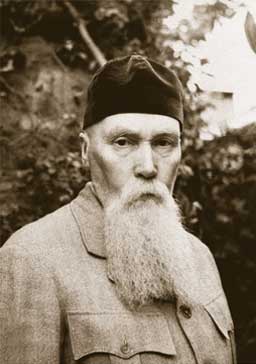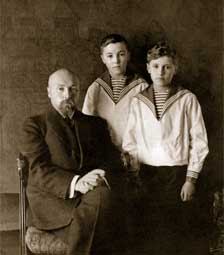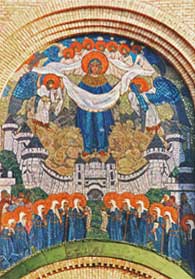In 1897, N. Roerich graduated from the Saint-Petersburg Academy of Arts, and his final project painting, “Messenger”, was acquired by the famous collector of Russian art work, P. Tretiakov. At the age of 24, Nicholas Roerich had already become an assistant to the Director of the Emperor’s Art Encouragement Society Museum and, at the same time, editor assistant of the art magazine “Mir Iskusstva” (“World of the Art”).
In his books, N. Roerich called Helena “inspirer” and “friendess”. She was the first to whom he showed each new painting and he highly appreciated her artistic intuition as well as her subtle taste. Many of the artist’s canvases were created on the basis of Helena’s images, thoughts, and creative insights. But her ideas were not only reflected in his paintings – it is hard to mention even one sphere in N. Roerick’s activities where these were not present. Behind each one of Nicholas Roerich’s creative acts, behind his verses and fairy-tales, behind his paintings and journeys – there will always be Helena Roerich. According to S. Roerich “collaboration of Nicholas and Helena Roerich was a most rare combination of full consonance on all planes. Supplementing each other, they seemed to merge in a richest harmony of intellectual and spiritual expression”[1, p. 49]. In 1903 – 1904, N. Roerich together with his wife made a trip to the old cities of Russia. They visited more than 40 cities famous for their ancient monuments. The aim of this “trip though ancient times” was the study of the roots of the Russian culture. The trip’s result was not only a wide series of the artist’s paintings, but also N. Roerich’s first articles. In them, he was one of the first to raise the issues surrounding the great artistic value of old Russian icon painting and architecture. The artist’s paintings on religious subjects in the form of frescoes and mosaic sketches for Russian churches also refer to the same period.
Nicholas Roerich’s multi-faceted talent brightly showed itself in his works for theatre productions. During S. Diagilev’s famous “Russian Seasons”,N. Roerich designed the production of “Polovets Dances” from Borodin’s “Prince Igor”, Rimsky-Korsakov’s “Pskovityanka”, and the ballet production of the “Sacred Spring” to Stravinsky’s music. Thanks to Helena Roerich, Nicholas Roerich became acquainted with the works of outstanding Indian thinkers – Ramakrishna and Vivekananda – they also became familiar with R. Tagor’s literary creations and they studied together the Upanishads. An acquaintance with the Oriental philosophical thought was reflected in N. Roerich’s creative work. While the core subjects of the artist’s earlier paintings was ancient pagan Russia with its colorful images of the folk epos and primeval splendor of the uncorrupted natural element (“They Build a City”, “Idols”, “Guests from Overseas”, etc.), starting already from the middle of the first decade of the 20th century, the theme of India and the East appears increasingly more frequently on his canvases and in literary pieces. In 1916, due to a severe illness of the lungs, in accordance with his doctors’ insistent advice, N. Roerich together with his family moved to Finland (Serdobol), to the Ladoga Lake coast. Proximity to Petrograd (Saint Petersburg) allowed him to go from time to time to the city on the Neva river and deal with the Art Encouragement Society School affairs. However, after the revolutionary events of 1917, Finland closed its borders with Russia, and N. Roerich with his family found himself cut off from his Motherland. In 1919, having received an invitation from Sweden, Nicholas Roerich traveled with exhibitions around the Scandinavian countries, and in the fall of the same year, he accepted S. Diagilev’s invitation to work as the designer for Russian operas to the music of M. Mussorgsky and A. Borodin in London, and together with his family went to England.
|
| ||||||||||||||||||||
Copyright © 2008-2024 ST. PETERSBURG BRANCH OF THE INTERNATIONAL CENTER OF THE ROERICHS
Life and creative work of Nicholas Roerich | Exhibitions | Excursions | Scientific research | Protection of the Roerichs' name and heritage



